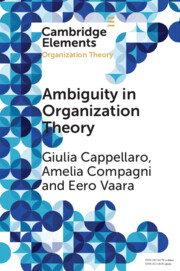Element contents
Ambiguity in Organization Theory
Published online by Cambridge University Press: 12 January 2023
Summary
Keywords
- Type
- Element
- Information
- Series: Elements in Organization TheoryOnline ISBN: 9781009358460Publisher: Cambridge University PressPrint publication: 02 February 2023
References
This Element is free online from 16th January 2023 - 30th January 2023
- 2
- Cited by



